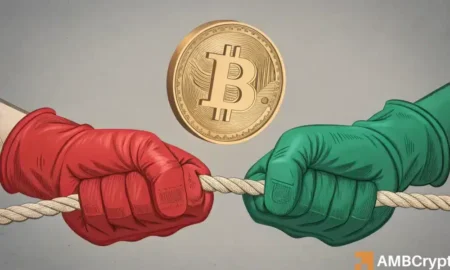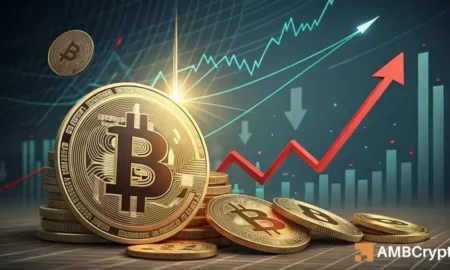BTC Decouples from U.S. Stocks Amid Fed-Trump Tensions: An SEO Optimized Overview
In recent developments, Bitcoin (BTC) has momentarily diverged from the performance of U.S. equities, showcasing its resilience amidst rising tensions between former President Donald Trump and the Federal Reserve. This juxtaposition reflects a notable trend where Bitcoin’s trajectory is increasingly becoming influenced by broader economic and political factors rather than solely by traditional market movements. Since the announcement of the ‘Liberation Day’ tariffs in early April, Bitcoin’s performance has generally mirrored that of risk-on U.S. stocks, suggesting a period of comparative stagnation. However, a resurgence in BTC prices was evidenced as it reached an impressive high of $88,800 just before the opening of U.S. market trading sessions.
Notably, this upward trend in Bitcoin prices coincided with significant market fluctuations. Gold also marked a record price of $3,500 per ounce, indicative of a collective shift by investors towards ‘safe-haven’ assets in light of escalating concerns surrounding the independence of the Federal Reserve. Analysts at QCP Capital posited that the market’s movements highlighted a widespread flight from U.S. equities, Treasuries, and the dollar, further exacerbated by Trump’s vocal discontent towards Fed Chairman Jerome Powell. Corroborating this sentiment, Trump’s remarks regarding Powell’s delay in cutting interest rates and his implicit threats to terminate Powell’s tenure have instigated swift and adverse market reactions against the dollar and U.S. stocks, while Bitcoin and gold notably flourished.
Amidst this volatile backdrop in the cryptocurrency market, stablecoin leader Circle has taken significant strides in innovation by launching a cross-border payment network (CPN) intended to compete with traditional systems like SWIFT, Mastercard, and Ripple. The operational inefficiencies prevalent in current platforms, such as prolonged transaction times and exorbitant fees (up to 6% on transfers), can hinder businesses and consumers alike. By employing fully reserved digital currencies such as digital dollars and euros, Circle aims to offer banks and payment service providers a faster and more affordable means of conducting cross-border transactions. As Nic Carter, a partner at Castle Island, points out, the CPN’s launch could effectively serve as a formidable alternative to traditional interbank payment frameworks.
However, not all news in the crypto landscape is positive. Ripple’s XRP has encountered potential regulatory difficulties stemming from a recent complaint lodged by the Oregon Attorney General against Coinbase. The complaint alleges that XRP, alongside Solana (SOL) and several other tokens, has been traded as unregistered ‘crypto securities’ on the platform. In response, Coinbase has criticized the lawsuit for its significant omissions, particularly in light of Judge Analisa Torres’ ruling, which determined that only sales of XRP to institutional investors could be classified as a ‘security.’ This looming uncertainty around regulatory clarity continues to keep a shadow over the cryptocurrency market as it strives for wider adoption.
In another pivotal moment for the regulatory landscape of cryptocurrencies, pro-crypto advocate Paul Atkins was recently sworn in as the 34th Chairman of the Securities and Exchange Commission (SEC). His confirmation on April 9, 2025, follows a Senate hearing where he affirmed his commitment to establishing a more ‘rational’ regulatory environment for the cryptocurrency sector. Market analysts, including Nate Geraci of ETF Store, anticipate that Atkins’ leadership could expedite pending applications for cryptocurrencies, including potential staking on Ethereum (ETH) exchange-traded funds (ETFs). This development could usher in a new era of regulatory scrutiny and clarity, which many believe is essential for the maturation of the cryptocurrency market.
The evolving relationship between cryptocurrency assets and traditional markets reveals a complex interplay influenced by regulatory developments, economic conditions, and political rhetoric. As Bitcoin continues to assert its place within the financial landscape, diverging from traditional assets like U.S. equities, the global financial system seems to be adapting to a new paradigm. This adaptability could be further reinforced by innovative initiatives like Circle’s cross-border payment solution and strengthened regulatory frameworks under the leadership of figures like Paul Atkins. As we move forward, investors will closely monitor these advancements and regulatory changes, determining how they will shape the future trajectory of cryptocurrencies.
In summary, Bitcoin’s recent decoupling from U.S. equities amidst Fed-Trump tensions marks a significant moment in the cryptocurrency landscape. With Circle’s ambitious plans to rival traditional payment systems, ongoing regulatory challenges for XRP, and the appointment of pro-crypto SEC Chairman Paul Atkins, the path forward for cryptocurrencies is laden with both opportunities and challenges. The next few months could be pivotal as the market and regulations evolve in response to these dynamic changes, propelling Bitcoin and other cryptocurrencies into a new chapter of growth and acceptance.
















